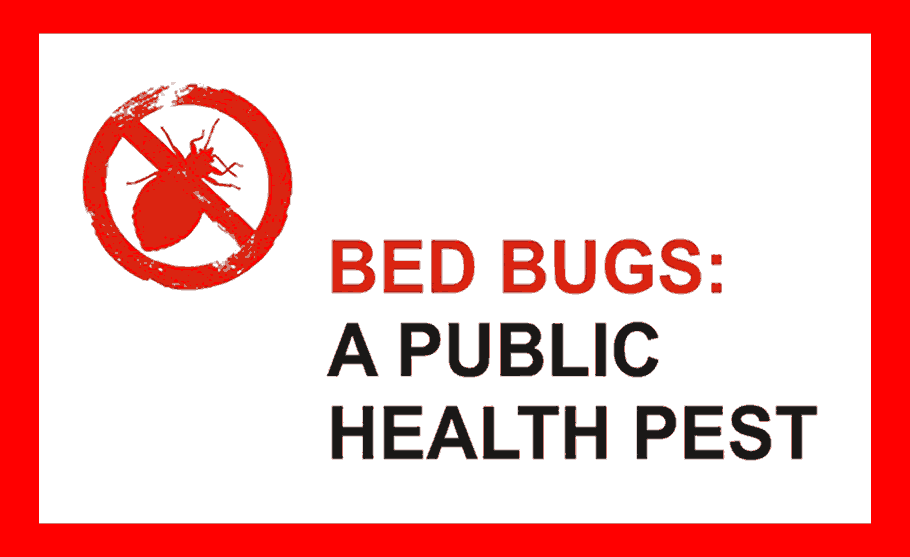Carpenter Bees
Information provded by Ohio State University.
Carpenter bees are so named because they excavate galleries in wood to create nest sites. They do not consume wood. Rather, they feed on pollen and nectar. Carpenter bees are important pollinators of flowers and trees. Carpenter bees typically are just nuisance pests that cause cosmetic rather than structural damage to wood. Nonetheless, considerable wood damage can result from many generations of carpenter bees enlarging existing galleries in wood.
Large carpenter bees belong to the genus Xylocopa. Two native species, Xylocopa virginica and Xylocopa micans, occur in the eastern United States. There also are a number of native carpenter bees in the western United States. This fact sheet primarily pertains to X. virginica, which has the common name of carpenter bee.
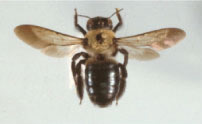 |
| Figure 1. Carpenter bee. (Courtesy of Kansas State University.) |
Identification
Carpenter bees are large and robust. X. virginica is three-fourths to one-inch long, black, with a metallic sheen. The thorax is covered with bright yellow, orange, or white hairs, and the upper side of the abdomen is black, glossy, and bare (Figure 1). The female has a black head, and the male has white markings on the head. Carpenter bees have a dense brush of hairs on the hind legs.
Carpenter bees somewhat resemble bumble bees, except bumble bees have dense yellow hairs on the abdomen and large pollen baskets on the hind legs. Various species of bumble bees and carpenter bees are similar in size. Bumble bees typically nest in the ground whereas carpenter bees nest in wood.
Life History
Carpenter bees are solitary insects that do not form colonies. Male and female carpenter bees overwinter as adults within their old nest gallery. Adults emerge in the spring (April and early May) and mate. There is one generation per year.
The males are not long lived, and the female carpenter bee prepares the nest. Gallery construction is a time and energy-consuming process, and the female will preferentially refurbish an old nest rather than excavate a new one. When constructing a new nest, the female uses her strong jaws (mandibles) to excavate a clean-cut, round nest entrance hole on the lateral surface of wood in an exposed or unexposed location. This hole is slightly less than 1/2-inch wide, approximately the diameter of her body. She bores into the wood perpendicular to the grain for one to two inches then makes a right angle turn (90deg.) and excavates along the wood grain for four to six inches to create a gallery (tunnel). She excavates the gallery at the rate of about one inch in six days.
The female bee creates a series of provisioned brood cells in the excavated gallery. The larval provision consists of a mixture of pollen and regurgitated nectar formed into a ball. The female forms a food ball at the far end of an excavated gallery, lays an egg on top of the mass, and then walls off the brood cell with a plug of chewed wood pulp. A female often creates six to 10 partitioned brood cells in a linear row in one gallery, and she dies soon thereafter. Larvae feed on the pollen/nectar food mass, which is sufficient food for them to develop to the adult stage.
The life cycle (egg, larva, pupa, adult) is completed in approximately seven weeks, although developmental time may vary depending on the temperature. The new adults typically remain in their gallery for several weeks then chew through the cell partitions and venture outside in late August. They collect and store pollen in the existing galleries, but also spend much of their time just huddled together inside a gallery. These new adults hibernate in galleries because they require shelter during the winter. They then emerge the following spring.
Habits
Carpenter bees nest in a wide range of softwoods and hardwoods, particularly if the wood is weathered. Eastern species of carpenter bees prefer softwoods such as cedar, redwood, cypress, pine, and fir. The bees can more easily tunnel through woods that are soft and that have a straight grain. Western species of carpenter bees often nest in oak, eucalyptus, and redwood.
Carpenter bees attack structural timbers and other wood products, including fence posts, utility poles, firewood, arbors, and lawn furniture. In buildings, carpenter bees nest in bare wood near roof eaves and gables, fascia boards, porch ceilings, decks, railings, siding, shingles, shutters, and other weathered wood. These bees avoid wood that is well painted or covered with bark.
The carpenter bee entrance hole in wood may not necessarily be in an exposed area. For example, the inner lip of fascia boards is a common site of attack. Nail holes, exposed saw cuts, and unpainted wood are attractive sites for the bees to start their excavations.
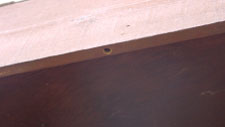 |
| Figure 2. Carpenter bee entrance hole in fascia. |
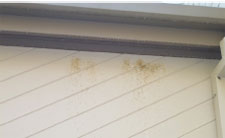 |
| Figure 3. Carpenter bee staining on siding below the fascia. |
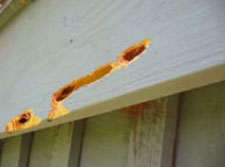 |
| Figure 4. Carpenter bee gallery exposed in wood. |
Economic Importance
Despite their beneficial aspect of being important pollinators of many trees and flowers, carpenter bees also may be nuisance pests around structures. Carpenter bees are noisy, which may be bothersome. These large bees create alarm when they dive-bomb or fly erratically around humans. In actuality, these are male bees, which are territorial but harmless because they lack a stinger. Only females have a stinger. Female carpenter bees are docile and are reported to sting only if handled.
Carpenter bees create a nuisance by excavating round entry holes in wood (Figure 2) and depositing yellowish to brownish streaks of excrement and pollen on surfaces below entry holes (Figure 3). They also produce coarse sawdust from their borings. The carpenter bee gallery system is confined within the wood (Figure 4) and hence is not visible.
Carpenter bee damage to wood initially is minor, and carpenter bees seldom cause consequential structural damage. However, their repeated colonization of the same wood can eventually cause considerable wood damage. Carpenter bees preferentially refurbish and enlarge an existing tunnel instead of boring a new one, and a gallery can extend for 10 feet if used by many carpenter bees over the years.
Carpenter bees sometimes construct new tunnels near old ones, with infestations persisting for several years. This complex system of tunnels can result in extensive damage to wood. Wood replacement is necessary when the strength of structural members, posts, poles, and other wood products is reduced due to carpenter bee damage.
Carpenter bees also may be indirectly responsible for unsightly wood damage when woodpeckers riddle the wood with holes searching for the developing carpenter bees to feed upon.
Contact Us ~ We can help!
Hours of operation: Monday through Friday 7:30 A.M. to 4:00 P.M. EST
Arab Pest Control, a division of Lewellen Services, Inc.
232 West Main St., Logan, OH 43138
800-654-8870
![]()
![]()


![]()
Serving Central And Southeastern Ohio Since 1980 • Family Owned And Operated• Fully Licensed By The State And Bonded And Insured. • Termite Warranties • Licensed Technicians • Extensive Training and Retraining• Uniformed Technicians• Marked Vehicles• All Pest Services Offered• Able To Tailor Services To Fit Your Needs• Convenient Hours• Polite And Courteous Staff • We Use The Up To Date Chemicals And Treatment Methods To Protect Your Family And Pets • Many Treatment Services Offered• Senior Citizen Discounts





